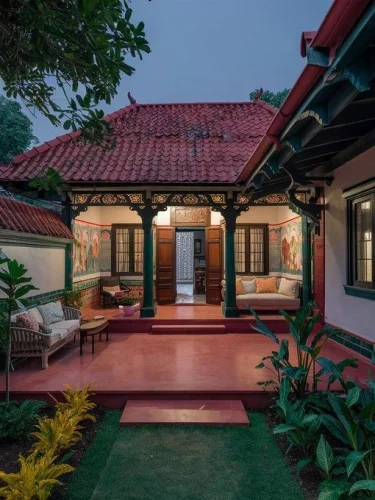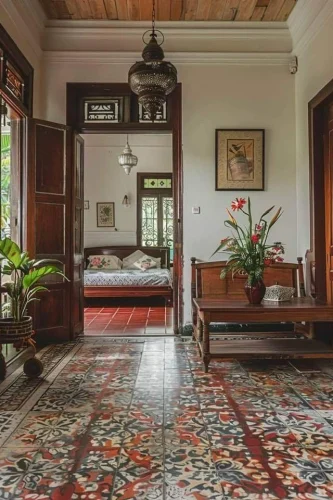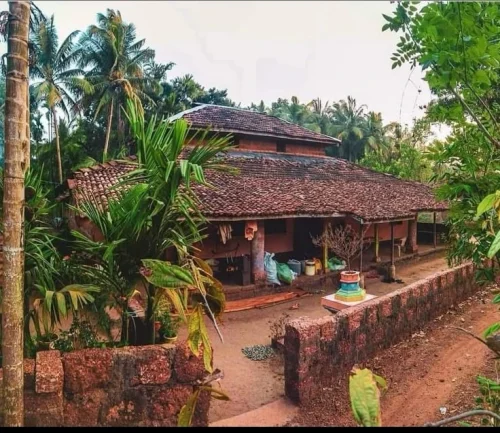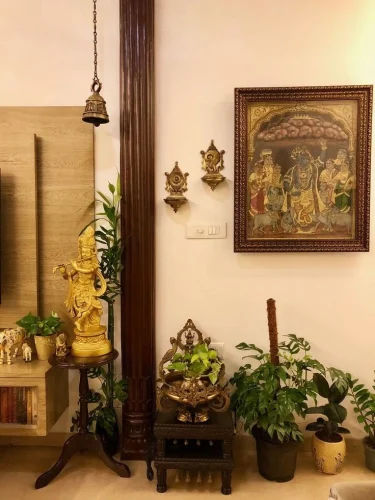
The Best Guide to Standard Window Frame Dimensions & Sizes
March 15, 2025
Mirror Location As Per Vastu 2025: Best & Worst Placements
March 17, 2025Introduction
South India has a rich culture and the South Indian houses are pieces of evidence of the region's rich heritage, architectural brilliance, and climatic adaptability. Not just the aesthetic appeal, the South Indian Houses offer a perfect mix of culture, practicality, and the way of life in the southern region of India.
In this blog, we will explore what sets South Indian homes apart, focusing on their interior layouts, building styles, and design elements.
Table of contents
Architectural Features of South Indian Houses
Source: Pinterest
South Indian houses are well-known in the world for their unique architectural elements. The South Indian homes are made according to the region's tropical climate and cultural practices.
One distinctive aspect of South Indian houses is the "thinnai” or verandah. It serves as a connecting zone between the outside and inside portions of the house.
Another defining characteristic is the central courtyard, known as the Naatu Kottai. This space is open from the sky, which allows natural light and ventilation in the house. The Naatu Kottai can be called the heart of the house, where all the family activities and festivals take place.
Also Read: Blending Classic Charm with Modern uPVC Window Designs
Interiors of Old Traditional South Indian Houses
Source: Pinterest
The interiors of old traditional South Indian houses are a blend of simplicity with elegance. However, the major focus is on natural materials and handcrafted details. Wood plays an important role in interior design, with intricately carved wooden pillars, doors, and ceilings adding warmth and character to the spaces. In traditional south Indian houses, flooring materials like red oxide or terracotta tiles are used, which keeps the house cool in hot and humid climates.
South Indian House Plans
The typical South Indian houses are designed to accommodate extended families and facilitate communal living. The design includes many connected rooms around a central open space, which helps bring in fresh air and sunlight.
Also, the bedrooms are made carefully to provide privacy while staying connected to the rest of the house. In South Indian houses or typically in Indian households, the kitchen is an important and sacred space. So, it is positioned in a specific direction based on tradition to make cooking easy and follow cultural beliefs.
Also Read: Door Materials for Maximum Home Security
South Indian Village House Designs
Source: Pinterest
South Indian village house styles depict a tight relationship with nature and communal lifestyle. The houses are built employing locally available materials such as mud, thatch, and wood, and therefore they are eco-friendly and sustainable.
Free space is granted topmost precedence in South India, where there are extensive verandahs and courts, a standard feature. Rain-heavy monsoon rain is kept away from reaching the wall by steeply pitched roofs having long eaves, and thick walls assist in keeping interiors cool.
The simplicity and functionality of these designs, coupled with their aesthetic appeal, make South Indian village houses timeless examples of incredible architecture.
South Indian Decor Elements
Source: Pinterest
South Indian decor is known for traditional artifacts, vibrant textiles, and craftsmanship. Most of the traditional homes have brass lamps known as “vilakkus”, which bring good luck and positive energy. The Furniture in traditional South Indian homes is usually made from strong wood like teak or rosewood, with beautiful carvings.
People often sit on low seating with cushions or floor mats for comfort. Brightly colored fabrics with traditional patterns make the home look even more attractive and welcoming. The houses have beautiful wall hangings and paintings with mythological stories that add color and culture to the space.
Also Read: How Windows and Doors Can Contribute to Green Building
Conclusion
South Indian homes mix style and practicality reflecting the area's traditions, weather, and community-focused way of life. The thinnai and central courtyard, along with detailed interiors featuring classic decorations, show us how to design in a smart and long-lasting way.
South Indian house layouts are thought out, while village homes have a down-to-earth appeal. At its core, South Indian building design aims to create cozy, sturdy, and good-looking places to live that can withstand the years. These homes highlight the region's knack for making spaces that work well and look great.
Green Fortune Doors And Windows: Way to a Sustainable Home
Green Fortune offers UPVC doors and windows that make your home beautiful and environmentally friendly. Our products are strong, long-lasting, and need little maintenance. Whether you want a modern shape or better insulation, Green Wealth is the right solution for you. Choose our permanent doors and windows and take a step towards a greener, Smart House!
Frequently Asked Questions (FAQs)
Q1: How can traditional South Indian design elements be incorporated into a modern home?
A: If you want to incorporate traditional South Indian designs in your modern home, then introduce a shaded verandah or sit-out area at the entrance, use red oxide flooring, install intricately carved wooden doors with metal detailing, and also incorporate fabrics and wooden furniture.
Q2: What makes a South Indian house unique?
A: The South Indian houses are specific due to their traditional architecture, and climate-friendly layout. Features like the thinnai, wood pillars, sloping roofs, and red oxide floors give an aesthetic appearance to South Indian homes. These houses also use natural materials like teak timber and terracotta, making them both beautiful and sustainable.
Q3: What are the common features of a South Indian house plan?
A: South Indian homes have a central courtyard, linked rooms, and a large hall for gatherings; the kitchen is positioned in a certain direction depending on traditional beliefs, therefore guaranteeing both utility and cultural relevance.











